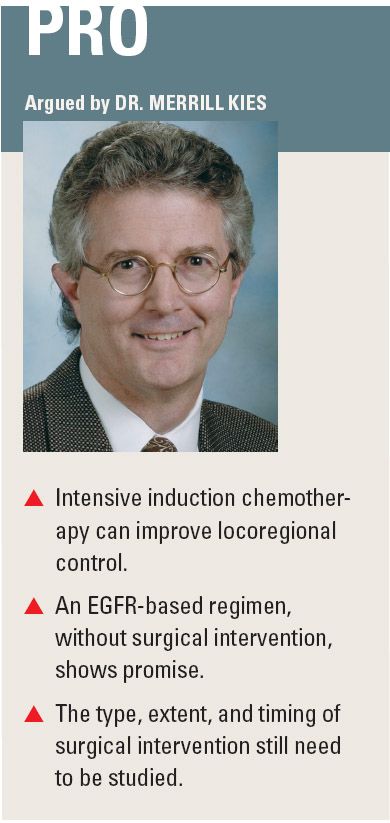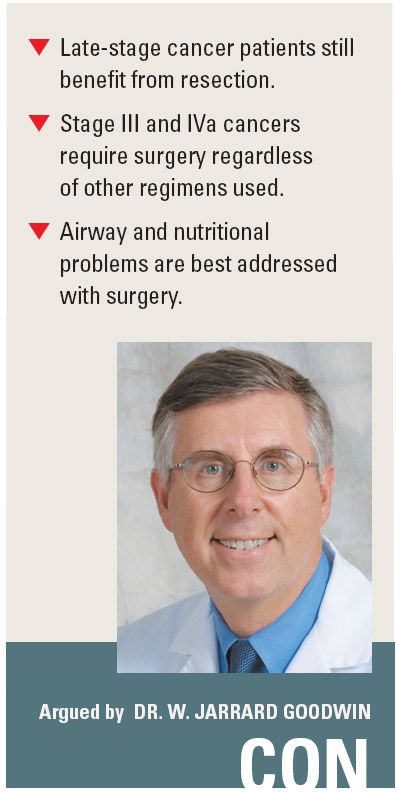Will Chemoradiotherapy End Surgical Dominance in the Treatment of Squamous Cell Head and Neck Cancers
HOLLYWOOD, FLA.-Two speakers at the 2009 Palm Beach Cancer Symposium agreed that surgery will always play a role in the treatment of squamous-cell head and neck cancers. The question at issue: Is surgery losing ground to chemoradiotherapy as the primary treatment for head and neck cancer?
The advent of powerful chemoradiation treatments may replace surgery for oropharynx cancers. On the other hand, these same new treatments could allow for more selective and efficient surgical intervention.
HOLLYWOOD, FLA.-Two speakers at the 2009 Palm Beach Cancer Symposium agreed that surgery will always play a role in the treatment of squamous-cell head and neck cancers. The question at issue: Is surgery losing ground to chemoradiotherapy as the primary treatment for head and neck cancer?

Merrill S. Kies, MD, argued the “pro” side of the issue-that surgery will not continue to be used as a matter of course in all head and neck cancer patients-focusing on the sophisticated chemotherapy and radiotherapy regimens now in use. Dr. Kies is professor of medicine and director of clinical programs, department of thoracic/head and neck medical oncology, at Houston’s M.D. Anderson Cancer Center.
Taking up the cause for surgery was W. Jarrard Goodwin, MD, director of the University of Miami’s Sylvester Comprehensive Cancer Center, who argued that despite advances in chemotherapy and radiotherapy, surgery will always retain a key role in the disease management. Dr. Goodwin is also a Sylvester Professor, department of otolaryngology, at the university’s Miller School of Medicine.
Modifications to local Rx
Dr. Kies cited research by the TAX 324 Study Group showing that intense induction chemotherapy results in improved outcomes. In that study, 501 patients with stage III or IV disease with no distant metastases were randomized to induction chemotherapy with docetaxel (Taxotere) plus cisplatin and fluorouracil (TPF) or cisplatin and fluorouracil (PF) followed by chemoradiotherapy with weekly carboplatin and radiotherapy. The patients in the TPF group had a significantly longer survival and better locoregional control than did patients in the PF group, the authors reported (N Engl J Med 357:1705-1715, 2007).
The fact that there was a difference in locoregional control with improved induction therapy “is a point that deserves emphasis and is an issue that is going to continue to be looked at very carefully,” Dr. Kies said.
In experimental work at his own institution, Dr. Kies and his group are studying EGFR inhibition with cetuximab (Erbitux) with weekly paclitaxel and carboplatin. Following six weeks of induction treatment, patients then proceeded to radiotherapy, with or without concomitant chemotherapy based on the extent of disease at diagnosis.
With follow up extending to three years, Dr. Kies called the results “promising,” especially in patients with stage T1 and T2 disease who were HPV positive. None of these patients failed the EGFR-based regimen.
Dr. Kies indicated that patients most likely to fail induction therapy were those who had hypoxia markers (elevated vascular endothelial growth factor and other markers) at the time of diagnosis.
In this study, surgical resection did not have much of an impact on outcomes. “We had planned to do surgery for patients who had evidence of residual disease within the neck,” Dr. Kies noted. “At our institution, we would also consider surgery as salvage for patients with persistent or refractory disease in the oral cavity. So, where does surgery fit into this?”

He stressed that the EGFR-based approach requires further study and is not yet ready for prime time. “We are not saying that if you get a good response to induction chemotherapy, then you don’t have to operate or give high-dose radiation or chemoradiation. That is a question that needs to be investigated in prospective trials,” he said.
In fact, Dr. Kies predicted that, as chemotherapy becomes increasingly effective, more surgeries will likely be performed. However, the type, extent, and timing of surgical intervention will need to be closely examined.
“We target distant and local disease with induction therapy, and this will eventually lead to modifications of local treatment as we increase the efficacy of our approaches. But we emphasize that modifications of definitive, potentially curative local therapy is a study question and should be treated accordingly,” he said.
Surgery for maintaining function
As a head and neck surgeon for 35 years, Dr. Goodwin has witnessed how surgical techniques for this disease have evolved, and he maintains that the role of surgery in head and neck cancer is still very important.
He pointed out that staging is extremely important in cancer of the head and neck. “Unfortunately, far too many patients-in fact the majority-continue to present with stage III and IV disease,” he said.
Stage I and II disease is relatively easily treated, usually with local therapy. Occasionally, he said, an unexpected postoperative pathology report of extracapsular or perineural spread in a lymph node will call for multimodal therapy with chemoradiation, but for the most part, surgery or radiation as local therapy produces an excellent cure rate and quality of life for these patients.
Stage III and IV disease is the big challenge, requiring surgery, radiation, and chemotherapy, which results in a highly variable, but consistently improving, cure rate. As the least homogenous of all squamous-cell head and neck cancers, stage IV disease should be broken down into stage IVa and stage IVb, Dr. Goodwin said.
“Stage IVa has a much better prognosis. Stage IVb is often an unresectable primary or a very advanced primary plus very advanced neck disease-the T4 and N3 patients, with whom we continue to have the biggest problem, especially if the tumor is outside the oral pharynx,” he said.
Depending on the pathology report, there are two ways to treat patients with stage III and IVa disease, he said:
• Surgery plus postoperative radiation with or without chemotherapy.
• Localized radiation therapy with or without chemotherapy and biologic therapy.
In stage III and IVa cases, he said, proper assessment of organ function is crucial in guiding treatment decisions: “If the organ is already not functioning and if the larynx, tongue, or oral pharynx is deeply involved or not functioning, it is pretty hard to bring that function back with chemotherapy and radiotherapy. In that type of patient, surgery may play a bigger role.”
Head and neck surgery has become more oriented to preserving organ function whenever possible. Research has also highlighted which patients will respond to salvage surgery. Dr. Goodwin recommended a paper that he authored on salvage surgery for patients with recurrent squamous cell carcinoma of the upper aerodigestive tract (Laryngoscope 110:1-17, supplement 93, 2000).
Dr. Goodwin acknowledged that improved methods of delivering radiotherapy have been a major advance in head and neck cancer treatment “In the past, all of our patients treated with wide field radiation therapy had significant loss of taste and salivation. We are seeing that so much less frequently now,” he said. Better chemotherapy techniques and the introduction of targeted therapy are also contributing to better patient outcomes, he added.
Nevertheless, he said, “I still think that the head and neck surgeon is an important member of the team in helping all of you who manage these patients. In many ways, because of the airway problems and the nutritional problems that we deal with in these patients, as well as the diagnostic capabilities that we now have, the head and neck surgeon is still the quarterback of the team.”
Newsletter
Stay up to date on recent advances in the multidisciplinary approach to cancer.